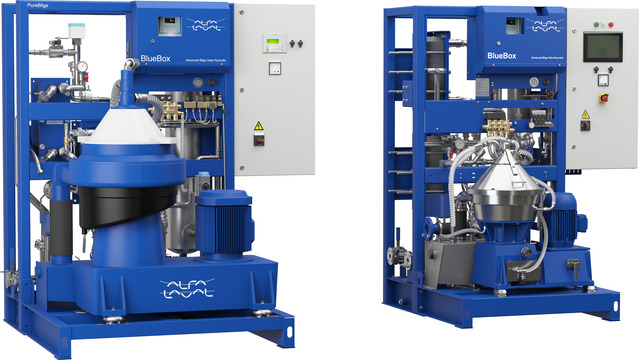PureBilge
PureBilge is a fully automated centrifugal oily water separation system that cleans oily water onboard vessels at sea. By effectively removing marine oil pollution, it makes oily water safe for discharge overboard.
Reliable, efficient, continuous
- Compact, modular, easy-to-install system saves time, space and money
- Continuous, single-stage operation requires less holding tank volume and provides more payload capacity
- Reduced operating costs thanks to low maintenance, automated control, minimal waste disposal, no chemical consumption and no disposable filter element
- Unaffected by sea heave, oil shocks or high solids loading
- Password-locked switch ensures only those responsible for environmental compliance may authorize discharge
Alfa Laval PureBilge is a high-speed centrifugal oily water separation (OWS) system that cleans large volumes. Its superior separation performance stems from the patented XLrator spiral inlet, which prevents oil droplets splitting and additional emulsions forming. It reduces operating costs by being designed for 24/7 unmanned operation. It doesn't require chemicals, adsorption filters or membranes.
This reliable single-stage high-speed centrifugal oily water separation (OWS) system effectively cleans large oily water volumes at sea as well as ashore without the use of chemicals, adsorption filter or membranes.
Cleaning efficiency
PureBilge, a high-speed centrifugal oily water separator generally achieves an oil-in-water content of less than 5 ppm. Performance has been proven under real-life operating conditions which are far tougher condition than IMO test requirements. In addition, PureBilge is unaffected by sea heave, oil shocks or high solids loading.
Superior separation performance
PureBilge features a patented XLrator disc inlet, which gently accelerates the oily water as it enters the separator bowl. This prevents the splitting of oil droplets and the formation of additional emulsions, which gives PureBilge a substantial edge over other centrifugal oily water separation systems.
Certified and cost-effective
Certified according to IMO resolutions, MEPC.107 (49) and US Coast Guard document 46 CFR 106.50, PureBilge is designed for unmanned 24/7 operation.
Certified in accordance with IMO regulations, MEPC.107 (49) and US Coast Guard document 46 CFR 106.50, PureBilge is designed for unmanned 24/7 operation.
Man-hours are not required for operation or supervision. Also, there is no reject to pump ashore and no need to transport land wastes such as filter elements, coalescence elements, active carbon, or flocculation deposits. This contributes to reduced operating costs.
Easy to install in any engine room
Designed for plug-and-play installation, PureBilge is a compact and factory-tested oily water separator module that is easy to install in any engine room. Continuous operation means that there is no need for large oily water holding tanks, which frees up space and increases payload capacity.
Fully automated monitoring and control
The new EPC 60 Bilge process controller is an easy-to operate, computer-based Alfa Laval process controller. It facilitates advanced fully automated monitoring and control of PureBilge functions by displaying in clear text process parameters, alarms and other data.
PureBilge options
PureBilge oily water separator includes a broad range of options that further simplify installation and maintenance. Choose the optional equipment that suits your requirements and the existing conditions on board:
- 5 ppm certificate
- Heat recovery
- Safety box
- Flow meter
- Sludge removal kit
- CIP unit
- Chemical dosing unit
- Automatic self-cleaning filter
- Remote control
Read the latest here
PureBilge separation capacities
PureBilge is available in two standard versions:
- PureBilge 2515: 2 500 l/h, 15 ppm
- PureBilge 2505: 2 500 l/h, 5 ppm
- PureBilge 5015: 5 000 l/h, 15 ppm
- PureBilge 5005: 5 000 l/h, 5 ppm
Πως δουλεύει
PureBilge oily water separator is a fully automatic, all-in-one system with a pumping stage, a preheating stage, and a centrifugal separation stage, with full process control and monitoring. It comprises a BWPX 307 high-speed separator, a control cabinet housing an EPC 60 bilge process controller, a valve and pipe rack and a feed pump module.
Operating principle
A feed pump with variable-frequency drive control directs oily water into the PureBilge system from the oily water settling tank or its equivalent.
After passing through a strainer that traps large particles present in the feed, the fluid passes through a heat exchanger that raises its temperature to the required level for optimum separation efficiency (generally 60-70ºC).
A three-way changeover valve then directs the fluid to the separation stage if all process conditions, such as feed temperature, feed pressure and separator speed, fall within preset process values. If any process condition is not met, the valve re-circulates the fluid back to the oily water settling tank.
The patented XLrator laminar flow inlet device gently accelerates the oily water into the separator bowl with a minimum of shearing and foaming. This greatly improves separation efficiency by preventing the splitting of oil drops and the further formation of emulsions. This is the key to PureBilge’s superior performance, compared to other centrifugal separation based systems.
PureBilge XLrator
The PureBilge disc-stack centrifugal separator rotates with a gravitational force of 6,000 G generated at 8,000 rpm. Oil and emulsions are separated from the oily water and discharged continuously through the oil outlet. Solids that collect at the separator bowl periphery are discharged intermittently at preset intervals and are directed to a collecting tank for sludge or waste oil.
A built-in water pump, or paring disc, continuously discharges separated oily water via the clean water outlet. The destination of the separated oily water depends upon its oil content, which is continuously monitored at an isokinetic sampling point by an oil-in-water monitor. If the oil content is below the preset alarm limit, which can be set from zero to 15 ppm, the separated oily water can be pumped directly overboard or into a ‘clean’ oily water holding tank for overboard discharge later. If the oil content exceeds the ppm limit, the effluent is returned for reprocessing.

